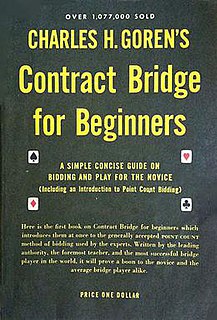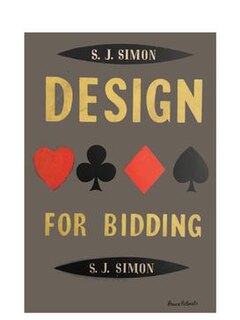In the card game contract bridge, the Losing-Trick Count (LTC) is a method of hand evaluation that is generally only considered suitable to be used in situations where a trump suit has been established and when shape and fit are more significant than high card points (HCP) in determining the optimum level of the contract. The method is generally not considered suitable for no trump or misfit hands; also, the trump suit is generally considered to require at least eight cards in length with no partner holding fewer than three.
A squeeze play is a technique used in contract bridge and other trick-taking games in which the play of a card forces an opponent to discard a winner or the guard of a potential winner. The situation typically occurs in the end game, with only a few cards remaining. Although numerous types of squeezes have been analyzed and catalogued in contract bridge, they were first discovered and described in whist.
In the card game of contract bridge, to hold up means to play low to a trick led by the opponents, losing it intentionally in order to sever their communication. The primary purpose is to give as many tricks to opponents as needed to exhaust all the cards in the suit from one of their hands. If that hand regains the lead, it will not be able to put the partner on lead to cash its tricks. Hold up is one of basic techniques in play.
The Drury convention is a bridge convention, used to show a game-invitational major suit raise by a passed hand while guarding against a light opening by partner in third or fourth seat. It is initiated by an artificial and forcing 2♣ response by the passed hand to a 1♥ or 1♠ opening by partner. The 2♣ bid shows at least 3-card support for opener's suit with 10-12 support points and asks opener to clarify the strength of his opening hand. The convention is also known in Europe as "Toronto".
A bridge convention is an agreement about an artificial call or a set of related artificial calls. Calls made during the auction phase of a contract bridge game convey information about the player's card holdings. Calls may be "natural" or "artificial".
Kamikaze 1NT is a preemptive 1NT opening in the game of contract bridge and in common practice shows a balanced hand with 10-12 high-card points (HCP) - also known as the mini-notrump range. It is used in first or second seat hoping to make 1NT opposite an average hand of about 10 HCP.
In the card game contract bridge, DONT is a conventional overcall used to interfere with an opponent's one notrump (1NT) opening bid. DONT, an acronym for Disturb Opponents' Notrump, was designed by Marty Bergen, and is therefore also referred to as "Bergen over Notrump". Although the method is often criticized for being too nebulous, it remains fairly popular. The convention was first published in the September/October 1989 issue of Bridge Today.
In contract bridge, various bidding systems have been devised to enable partners to describe their hands to each other so that they may reach the optimum contract. Key to this process is that players evaluate and re-evaluate the trick-taking potential of their hands as the auction proceeds and additional information about partner's hand and the opponent's hands becomes available.
Ron Klinger is an Australian contract bridge player and a leading English-language bridge writer, the author of more than 70 books on the game. He is an Australian Grand Master and a World Bridge Federation International Master.
Hugh Walter Kelsey was a Scottish bridge player and writer, best known for advanced books on the play of the cards.
The opening lead is the first card played in the playing phase of a contract bridge deal. The defender sitting to the left (LHO) of the declarer is the one who makes the opening lead. Since it is the only card played while dummy's cards are still concealed, it can be critical for the outcome of the deal. Making the best opening lead is a combination of selecting the best suit and then the best card within that suit.
Mark Howard Horton is a British bridge journalist and expert player, as well as a former lawyer and chess champion. He has been the editor of Bridge Magazine since 1995. He currently lives in Bath with his partner Liz.
Marc Smith is a British bridge player, columnist and writer. Marc Smith represented Great Britain as a junior, winning the 1985 European Union Junior Teams Championship. He has a host of wins in national events, and reached the final of the World Mixed Pairs Championship playing with his wife, Charlotte. His book, co-authored with Barbara Seagram, 25 Bridge Conventions You Should Know, won the American Bridge Teachers' Association 1999 Shirley Silverman Award for Best Student Book.

Contract Bridge For Beginners is a book written by Charles Goren on the rules and basic strategies of contract bridge. First published by Simon & Schuster Inc. of New York in 1953 and by Eyre & Spottiswoode of London in 1959, each has been reprinted numerous times. The book contains an introduction to the then relatively new bidding system condensed from Goren's historically significant 1947 book Point Count Bidding in Contract Bridge.

Bridge Squeezes Complete is a book on contract bridge written by Ann Arbor, Michigan-based mathematics professor Clyde E. Love, originally published in 1959. Written in a "dry, mathematical way", it is still considered one of the most important bridge books ever written and the squeeze vocabulary Love invented remains the basis for all discussions of squeezes.
Texas transfer, or simply Texas, is a bidding convention in contract bridge designed to get the partnership to game in a major suit opposite a one notrump or two notrump opening, thus making the opener declarer and keeping the stronger hand hidden from the opponents. Texas is used in response to a notrump opening when holding a six-card or longer major suit and at least game-going features; responder may have interest in slam via continuations in Blackwood or its variants. Originated independently by David Carter of St. Louis and Olle Willner of Sweden,

Design for Bidding is a book by the Russian-born English bridge player S. J. "Skid" Simon, published posthumously in 1949. It is about the theory of bidding in contract bridge, particularly in the context of the Acol system of which Simon was one of the co-developers. It was the first, and as of 2015, remains one of the few, studies of the thought processes involved in designing a bidding system, rather than simply setting out the author's conclusions.


